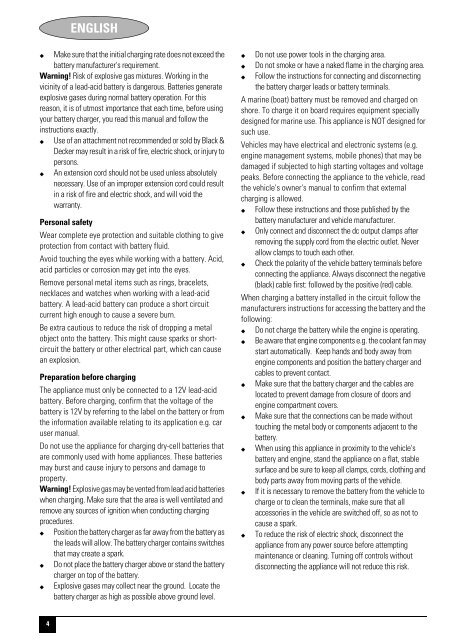BlackandDecker Battery Booster- Bdv080 - Type 1 - 2 - Instruction Manual (Europeo)
BlackandDecker Battery Booster- Bdv080 - Type 1 - 2 - Instruction Manual (Europeo)
BlackandDecker Battery Booster- Bdv080 - Type 1 - 2 - Instruction Manual (Europeo)
Create successful ePaper yourself
Turn your PDF publications into a flip-book with our unique Google optimized e-Paper software.
ENGLISH<br />
Make sure that the initial charging rate does not exceed the<br />
battery manufacturer's requirement.<br />
Warning! Risk of explosive gas mixtures. Working in the<br />
vicinity of a lead-acid battery is dangerous. Batteries generate<br />
explosive gases during normal battery operation. For this<br />
reason, it is of utmost importance that each time, before using<br />
your battery charger, you read this manual and follow the<br />
instructions exactly.<br />
Use of an attachment not recommended or sold by Black &<br />
Decker may result in a risk of fire, electric shock, or injury to<br />
persons.<br />
An extension cord should not be used unless absolutely<br />
necessary. Use of an improper extension cord could result<br />
in a risk of fire and electric shock, and will void the<br />
warranty.<br />
Personal safety<br />
Wear complete eye protection and suitable clothing to give<br />
protection from contact with battery fluid.<br />
Avoid touching the eyes while working with a battery. Acid,<br />
acid particles or corrosion may get into the eyes.<br />
Remove personal metal items such as rings, bracelets,<br />
necklaces and watches when working with a lead-acid<br />
battery. A lead-acid battery can produce a short circuit<br />
current high enough to cause a severe burn.<br />
Be extra cautious to reduce the risk of dropping a metal<br />
object onto the battery. This might cause sparks or shortcircuit<br />
the battery or other electrical part, which can cause<br />
an explosion.<br />
Preparation before charging<br />
The appliance must only be connected to a 12V lead-acid<br />
battery. Before charging, confirm that the voltage of the<br />
battery is 12V by referring to the label on the battery or from<br />
the information available relating to its application e.g. car<br />
user manual.<br />
Do not use the appliance for charging dry-cell batteries that<br />
are commonly used with home appliances. These batteries<br />
may burst and cause injury to persons and damage to<br />
property.<br />
Warning! Explosive gas may be vented from lead acid batteries<br />
when charging. Make sure that the area is well ventilated and<br />
remove any sources of ignition when conducting charging<br />
procedures.<br />
Position the battery charger as far away from the battery as<br />
the leads will allow. The battery charger contains switches<br />
that may create a spark.<br />
Do not place the battery charger above or stand the battery<br />
charger on top of the battery.<br />
Explosive gases may collect near the ground. Locate the<br />
battery charger as high as possible above ground level.<br />
Do not use power tools in the charging area.<br />
Do not smoke or have a naked flame in the charging area.<br />
Follow the instructions for connecting and disconnecting<br />
the battery charger leads or battery terminals.<br />
A marine (boat) battery must be removed and charged on<br />
shore. To charge it on board requires equipment specially<br />
designed for marine use. This appliance is NOT designed for<br />
such use.<br />
Vehicles may have electrical and electronic systems (e.g.<br />
engine management systems, mobile phones) that may be<br />
damaged if subjected to high starting voltages and voltage<br />
peaks. Before connecting the appliance to the vehicle, read<br />
the vehicle's owner's manual to confirm that external<br />
charging is allowed.<br />
Follow these instructions and those published by the<br />
battery manufacturer and vehicle manufacturer.<br />
Only connect and disconnect the dc output clamps after<br />
removing the supply cord from the electric outlet. Never<br />
allow clamps to touch each other.<br />
Check the polarity of the vehicle battery terminals before<br />
connecting the appliance. Always disconnect the negative<br />
(black) cable first: followed by the positive (red) cable.<br />
When charging a battery installed in the circuit follow the<br />
manufacturers instructions for accessing the battery and the<br />
following:<br />
Do not charge the battery while the engine is operating.<br />
Be aware that engine components e.g. the coolant fan may<br />
start automatically. Keep hands and body away from<br />
engine components and position the battery charger and<br />
cables to prevent contact.<br />
Make sure that the battery charger and the cables are<br />
located to prevent damage from closure of doors and<br />
engine compartment covers.<br />
Make sure that the connections can be made without<br />
touching the metal body or components adjacent to the<br />
battery.<br />
When using this appliance in proximity to the vehicle's<br />
battery and engine, stand the appliance on a flat, stable<br />
surface and be sure to keep all clamps, cords, clothing and<br />
body parts away from moving parts of the vehicle.<br />
If it is necessary to remove the battery from the vehicle to<br />
charge or to clean the terminals, make sure that all<br />
accessories in the vehicle are switched off, so as not to<br />
cause a spark.<br />
To reduce the risk of electric shock, disconnect the<br />
appliance from any power source before attempting<br />
maintenance or cleaning. Turning off controls without<br />
disconnecting the appliance will not reduce this risk.<br />
4
















